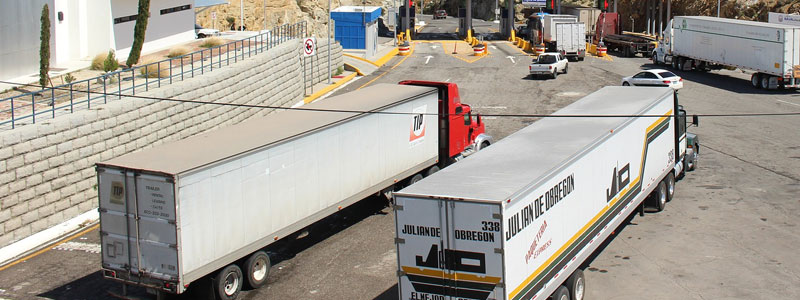Smart Caps and Self-Driving Trucks: The Future of the Trucking Industry
Trucking companies face two major problems today: drowsy drivers and a shrinking workforce. The Hours of Service regulations prevent truckers from being on the road for more than 11 hours at a time in an effort to combat drowsy driving. Far from being the fault of drivers, drowsy driving is simply a fact of biology: […]

December 4, 2017

Trucking companies face two major problems today: drowsy drivers and a shrinking workforce.
The Hours of Service regulations prevent truckers from being on the road for more than 11 hours at a time in an effort to combat drowsy driving. Far from being the fault of drivers, drowsy driving is simply a fact of biology: sitting in one place for hours at a time and concentrating on operating a large vehicle is bound to make a person tired. The Hours of Service regulations attempt to ensure that every trucker on the road is well rested. However, these regulations limit how quickly companies can expect trucks to deliver goods, causing problems for the trucking industry.
The industry’s shrinking workforce, however, is perhaps the more pressing issue. Currently, the industry faces a shortage of 50,000 drivers. The average truck driver is 55 years old, so many are expected to retire over the next five to ten years, increasing the shortage dramatically. By 2025, experts expect the industry will need 890,000 new drivers.
Two new technological advancements are aiming to help alleviate, if not altogether solve, these problems: Ford’s new SafeCap and Embark’s new driverless trucks.
Ford’s SafeCap Prevents Drowsy Driving

Ford unveiled the SafeCap last month for the sixtieth anniversary of its truck production in Brazil. Outfitted with gyroscopes, sensors, and software, the product still looks like any other trucker cap. However, its extra features allow it to detect when a driver is succumbing to drowsy driving.
The Ford SafeCap uses three different signals when it has detected drowsiness: vibration, sounds, and flashing lights. They’re supposed to let the driver know it’s time to pull over and take a break.
Ford studied head nods to make sure the cap would only detect drowsiness when a person began nodding off, rather than when a person was nodding their head to music or moving their head to merge into another lane, for example.
Although the SafeCap isn’t slated for mass production anytime soon, it shows that automakers like Ford are taking steps in the right direction to prevent drowsy driving. After testing in Brazil, Ford will likely expand to larger markets.
Why is drowsy driving a problem in the first place? Well, driving when you’d rather be sleeping is actually just as dangerous as driving while drunk. After 18 hours without sleep, a person’s driving ability is equal to a person who has a .05 blood alcohol level, according to the National Sleep Foundation. If a person hasn’t slept in a full 24 hours, they’ll drive like a person with a .10 blood alcohol content, well above the legal limit of .08.
According to the National Highway Traffic Safety Administration (NHTSA), drowsy driving contributed to 83,000 car accidents from 2005 to 2009, and 846 people died in 2014 due to accidents caused by drowsy driving. If a trucker cap can make any difference in these statistics, it may be worth wearing.
Embark’s Self-Driving Trucks

Embark isn’t the first company to create self-driving trucks, and it certainly won’t be the last. Volvo, Daimler, Tesla, and even Uber are all pioneers in the self-driving truck industry. But Embark gained some press coverage this fall when its driverless semi trucks successfully hauled Frigidaire refrigerators 650 miles across Southern California.
Embark’s use of self-driving trucks is similar to a port system. A person is still needed to pick up the cargo (in this case, refrigerators) and haul them to a “port” right off of the highway. Then, an Embark employee hitches the trailer to the driverless truck, gets it onto the interstate, and turns on autonomous mode. The truck drives itself on the highway for hundreds of miles until it reaches the exit nearest to the destination. At that point, the Embark employee takes over, pulls over, and unhitches the trailer. A normal truck driver comes along and takes the trailer to its final destination just a few miles away.
The concept of self-driving trucks not only solves the drowsy driver and shrinking workforce problem, but may also solve the problem of truck accidents. More than 4,000 people die in truck accidents every year in the United States, and most accidents are caused by human error, according to Wired. Although these self-driving trucks are far from foolproof yet—most are still in development and being tested—many automakers are hopeful that a computer-driven truck will make fewer mistakes than a human-driven one, possibly saving lives.
Help After an Indiana Truck Accident
Of course, for now, smart caps and self-driving trucks are still in the (not-too-distant) future. Many truck accidents will continue to happen as long as humans are at the wheel, whether in trucks or in passenger vehicles.
If you’ve been injured in a truck accident, whether as a truck driver yourself or as a person driving a passenger vehicle, Hensley Legal Group can help. Call us today or contact us online to speak with our experienced truck accident lawyers. Your initial consultation is free.
Available 24/7
Free Case Review
You won’t pay any fees until we win your case.
It’s easy - you can: